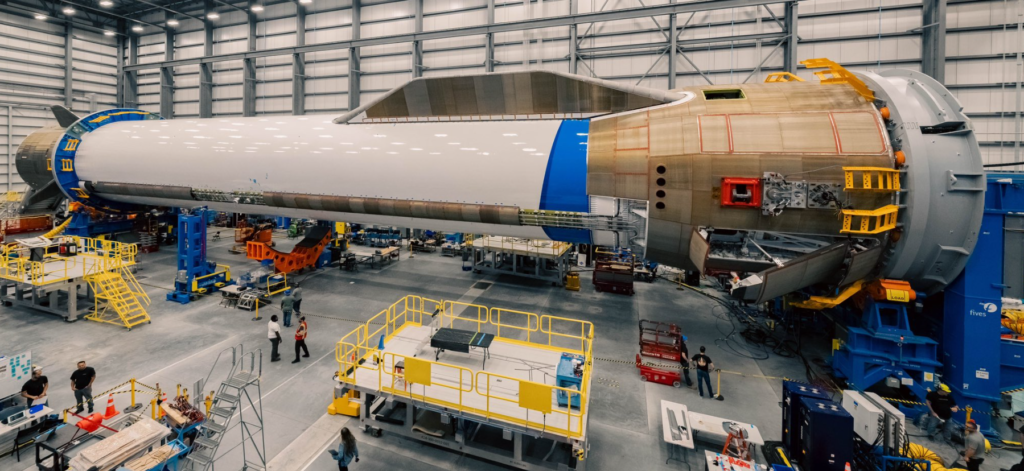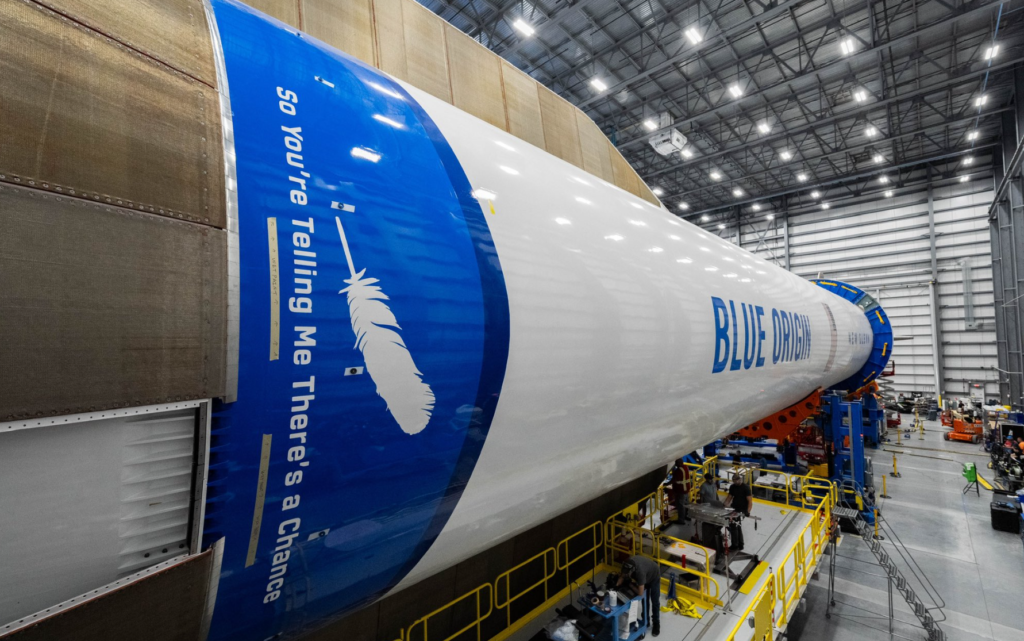If everything stays on schedule, Blue Origin believes they can launch New Glenn in about two months this November. While the original date and payload have changed, the goal of landing and reusing the first booster is still a major priority for the company.
So much so that they even named the booster in relation to the first landing attempt. They also shared more images highlighting the installation of strakes, New Glenn heat shielding, and upcoming steps. Here I will go more in-depth into the new launch timeframe, the final tests, what to expect, and more.
Landing The Booster

A few days ago on the 11th Dave Limp, the CEO of Blue Origin, shared a new image of the booster in addition to a few comments about its progress and current state. Here he was quoted saying, “Some of you recently asked additional questions about Comet, the thermal protection system we created for New Glenn, and whether we’ll paint it on our vehicle.”
“We could—but have chosen not to for a variety of reasons, including adding unnecessary weight. It has been applied on our fins, forward module, strakes, tank tunnel, and the aft section, including the legs. As for the color, you tell me: Copper? Gold? Brown? Given the the thermal environment, we expect the material will change colors on our booster as we fly multiple missions” he said.
Originally on practically all New Glenn renderings most of these thermal protected areas were painted white with the exception of the aft module which was painted a dark grey. It seems that to save time and convenience, they decided just to leave the sections as is. In a way, this is similar to the Space Shuttle which for some of the initial missions had its external tank painted white before the agency decided it just wasn’t worth it.
Focusing back on New Glenn, he then went on to talk about the strakes which were just installed. Here he said, “the strake you see at the top of the image, there are two of them, and each is about the size of an F-16 wing and carries 175,000 lbs of lift when our stage re-enters for landing on Jacklyn. The strake is designed to accommodate two inches of thermal “growth” during the different phases of flight. In other words, there are temperature differences during the mission of up to several hundred degrees Fahrenheit that cause the tank to shrink and the strakes to grow” he said.
In order to get an idea of Blue Origin’s timeline and work speed, late last month on the 27th Limp shared a picture of New Glenn as the aft module was being mated to the mid module. At the time he mentioned that the next steps were installing the 7 BE-4 engines, the two starkes, and the base heat shield panels. It’s now been about 20 days and the strakes are obviously installed but no update yet on the BE-4 engines. If that hasn’t already been completed, it likely is the next step and almost ready.
This leads us to yesterday when Dave Limp shared another image of the vehicle. This one was on the other side of the booster highlighting its name painted on the bottom of the mid-module, “So You’re Telling Me There’s a Chance.
With this, he said, “We have a cool history naming key Blue hardware that dates back to New Shepard. We’re calling New Glenn’s first booster “So You’re Telling Me There’s a Chance.” Why? No one has landed a reusable booster on the first try. Yet, we’re going for it, and humbly submit having good confidence in landing it. But like I said a couple of weeks ago, if we don’t, we’ll learn and keep trying until we do” he said.
Based on these comments, it’s clear Blue Origin is genuinely confident of landing this booster on the maiden flight. They have some experience with New Shepard but even still there are some major differences this time around. For one the booster is significantly larger. Standing at around 57m tall and 7m wide, there’s a lot more rocket that needs to land. You then have the first use of BE-4 engines on New Glenn which will need to throttle and perform perfectly.
Arguably more important than all those elements is the fact that it won’t be returning to land but instead an autonomous landing platform out at sea. If the company were able to land this booster first try, it would be extremely impressive and a massive milestone for Blue Origin.
In the event that it doesn’t, they have already expressed the plan to keep trying until they get it right. In that regard, it’s also important to consider that the current landing vessel is the only one the company has. Any significant damage from a failed landing attempt could delay some future attempts.
In the past, we saw SpaceX attempt a very similar process, and they ended up with quite a few failures before finally getting it right. It just goes to show the difficulty of the process and some of the challenges Blue Origin is about to face.
Launch Date Change

In addition to physical progress and trying to land the booster first try, earlier this month NASA announced a change to the mission. Specifically on September 6th, they tweeted saying, “NASA’s ESCAPADE (Escape and Plasma Acceleration and Dynamics Explorers) mission is now targeting a launch in 2025. ESCAPADE’s two satellites will investigate how solar wind interacts with the magnetic environment of Mars.
This mission was originally set to happen this year in mid-October and be New Glenn’s maiden flight. In response, Blue Origin tweeted saying, “We’re supportive of NASA’s decision to target the ESCAPADE mission for no earlier than spring 2025 and look forward to the flight. We plan to move up New Glenn’s second flight, originally scheduled for December, into November. New Glenn will carry Blue Ring technology and mark our first National Security Space Launch certification flight. We’ll provide more details on these launch plans in the coming weeks.
Keeping Mars launch windows in mind which usually occur every two years, there were questions as to how Blue Origin would launch a Mars mission around 6 plus months after the original window. In response NASA said, “The mission team is analyzing larger planetary window opportunities. NASA and Blue Origin are discussing an additional opportunity to launch the spacecraft to Mars no earlier than spring 2025” they said.
Basically, thanks to the power of New Glenn and the small size of the two ESCAPADE spacecraft, the vehicle can make up for the less-than-ideal launch timeline and still get the two spacecraft to their destination.
As far as why the launch was pushed back, it came down to NASA’s confidence in Blue Origin’s ability to be ready by October. Around this time, NASA would fuel the two spacecraft in preparation for a launch in October. In the event that they fuel the spacecraft and New Glenn misses the launch window, it causes some pretty big issues and time concerns. Specifically, the agency was quoted saying, “The decision was made to avoid significant cost, schedule, and technical challenges associated with potentially removing fuel from the spacecraft in the event of a launch delay, which could be caused by a number of factors.”
While not ideal for the company, a maiden flight being pushed back one month is not the end of the world. What was interesting was the decision to move up the second flight one month into November. That’s something the company wouldn’t do unless they were very confident that the vehicle would be ready to launch by that time.
As mentioned prior, it also will now be carrying Blue Ring. Just about a year ago Blue Origin unveiled Blue Ring, which is a spacecraft platform focused on providing in-space logistics and delivery. In an official statement, they said, “Blue Ring serves commercial and government customers and can support a variety of missions in medium Earth orbit out to the cislunar region and beyond. The platform provides end-to-end services that span hosting, transportation, refueling, data relay, and logistics, including an “in-space” cloud computing capability. Blue Ring can host payloads of more than 3,000 kg and provides unprecedented delta-V capabilities and mission flexibility” they said.
The Senior Vice President of Blue Origin’s In-Space Systems also commented, “Blue Ring addresses two of the most difficult challenges in spaceflight today: growing space infrastructure and increasing mobility on-orbit. We’re offering our customers the ability to easily access and maneuver through a variety of orbits cost-effectively while having access to critical data to ensure a successful mission” he said.
It’s important that Blue Origin has a successful maiden flight not only because of the payload but also because it will now be a National Security Space Launch certification flight. The faster they can get the vehicle certified and proven to be a capable launcher, the more launch contracts and options they have for the future.
Over the next few weeks, we should expect to hear a lot more from the company. This includes information on the upper-stage static fire, an upcoming first-stage static fire, an eventual full stack, and more. If every one of these tests goes well, it’s possible that they stay on schedule and are able to launch before the end of this year. When that does happen, we’ll be able to see not only the launch itself but also an ambitious booster landing attempt.
Conclusion
The strakes are now installed meaning the first stage is just about complete and ready for final testing. At the same time, Blue Origin prepares for the first landing attempt which they are confident has a good possibility of being successful.
